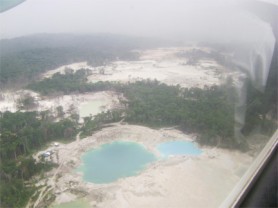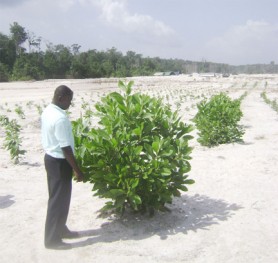Blue water sparkles in the sunlight as machinery sounds faintly in the distance. A wasted landscape of craters and sand is surrounded by towering trees, some stripped bare of leaves.

White Hole, Mahdia, Region Eight. Tiny green seedlings are barely visible against the glowing sand. There are hundreds of them. Waving gently in the breeze, the fast-growing Acacia plants represent one of the first major projects to reforest land left damaged by mining. With environmental management issues being among the most critical and controversial concerns facing the small and medium-scale gold and diamond mining industry here, the project seeks to show that mining and the environment can go hand in hand.
The project is moving along well, Devon Agard, environmental officer attached to the Guyana Gold and Diamond Miners Association (GGDMA) said during a visit to the area last week. The GGDMA is collaborating with regulatory agency, the Guyana Geology and Mines Commission (GGMC) and the Guyana Environmental Capacity Development Project (GENCAPD) on this and a few other projects, including a Water and Tailings Management project at the same location.
The need to marry mining practices with good environmental management has long been a sore issue here. In the past, mining sector representatives and environmentalists have, in principle, agreed that better environmental practices in the sector are vital. But the reality on the ground is somewhat different. The GGMC has grappled with staff shortages, and denuded land and polluted and discoloured rivers mar swathes of the green interior of Guyana. Issues such as mercury pollution have been raised time and again by indigenous groups and organizations like the World Wildlife Fund (WWF).

However, in recent months, as government launched its Low Carbon Development Strategy and signed a Memorandum of Understanding with the Kingdom of Norway that would see Guyana receiving money for preserving its forests, the environment has come under renewed focus with moves to tighten regulations.
In the mountainous forests surrounding Mahdia, discoloured ponds and streams and patches of bare earth mar the landscape. Giant trees, grey, stripped and dead, lie scattered amid craters and mounds of sand. Miners have argued that the industry is an extractive one and some amount of disturbance of the environment is inevitable. But reclamation efforts have been minimal.
The Acacia project, in the heart of mining country, aims to replant the land left degraded by mining, and become a model that miners can emulate. Five thousand fast-growing Acacia plants are to be planted with 1,200 put down so far. A similar project is planned for Port Kaituma in Region One.
Miners are interested, Agard said in an interview with Stabroek News last week. He noted that miners’ stance on the environment has shifted over the past few years. But, he says, there is a lack of education and awareness about simple methods they can use to minimize environmental damage. In rehabilitating land, one of the main issues that miners look at is cost, he stated. He said miners see this as expensive. “We’re trying to make it economical for them, trying to show them it’s not a big task,” he declared.
And there are cost-effective methods. Agard advocates “progressive” mining where operators position their sluice boxes in such a manner that the waste from one area refills an area already mined. When the operation closes, it is just a matter of lowering any bumps and replanting trees native to the area, he said. “They can mine with the environment in mind. It is not just extraction of minerals. They must extract in a way so that they can restore the area to some sort of natural semblance,” he asserted.
He stressed that awareness and education are important, noting that the key to fixing a problem is having the knowledge to fix it. This has been lacking but is changing slowly.” They know to themselves, [they have to embrace] sustainability but have no knowledge,” the environmental officer commented.
Agard has been carrying his message to miners across the country and he said the problem is pretty much the same in the various districts. But the message is getting across, he said.
It did not seem to be so before. When the 2005 environmental Mining Regulations were enacted, miners were given a two-year grace period to comply. However, several expeditions by this newspaper into the mining fields including at Arau (Region Seven) and at Quartz Hill (Region Eight) found that enforcement was lax and there were major breaches with little or no action by authorities.
Scoping
University of Guyana Professor, Dr Clive Thomas in a scoping study of the small and medium-scale gold and diamond mining industry last year noted that in six out of nine mining areas surveyed, the degree of degradation was classified as “severe.” He cited one study which stated “current degraded areas are not likely to recover… the reason being that there is little if any reclamation by miners with modern mining technologies.”
But, according to the study, overall, land degradation from mining is “negligible” at 3.66% or 5.6% of the area available for mining. This figure does not take into account large-scale mining operations. It noted that the degree of degradation is “moderate to severe” but control and full rehabilitation of the land is possible. But, the rate of degradation is “moderately increasing” with there being a positive relationship between the industry’s expansion and increased rate of degradation. The main drivers of degradation have been attributed to both policy-related and market-related failures including, in the case of the former, absence of a national land use policy and plan, regulatory weaknesses, insufficient monitoring and enforcement, among others.
Sitting in one of the numerous bars in Mahdia, veteran miner, George Canterbury dismisses any suggestion that miners do not want to work in accordance with environmental regulations. “When certain things happen, for example, a dam break away, a small miner would not have the equipment to do repairs. It’s not really that you want to destroy the environment,” he explains. Miners need more education and help, opined Malcolm McLean, 15 years a miner. He said, however, that the mining they do is mostly “swamp mining” and commercially valuable trees are hardly affected and the vegetation grows back quickly. “We’re not here to damage the environment,” he emphasized.
One of the points argued by miners is that in the forest, natural re-growth occurs quickly and in three to four months, plants are evident without any sort of intervention.
Agard noted that where the soil is very poor, efforts have to be made to do replanting. He said they are pushing for miners to do dry-mining to reduce the amount of waste being generated.
“Change will happen. That’s why we are trying to build awareness of simple techniques… how miners can exploit minerals in a safe way without too much impact on the environment,” Agard explained, stating that there is a far way to go. “With awareness building to raise standards in the shortest possible time, we will reach this elevation,” he added.
Viewed from the air, the Acacia project site is an area of blue lakes and white sand. Surrounding Mahdia, the numerous bare patches and discoloured ponds stand in stark contrast to the green forests. The Acacia project is dwarfed but the tiny plants are there.




